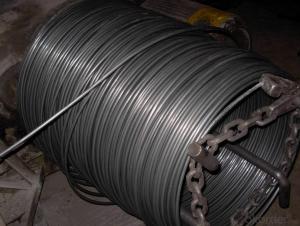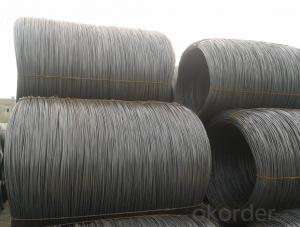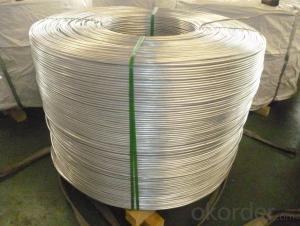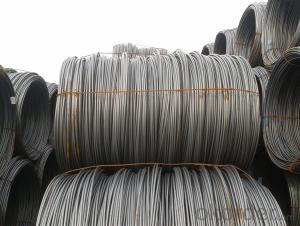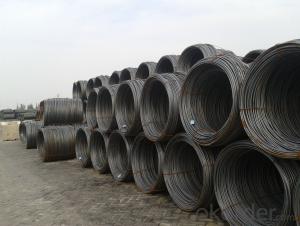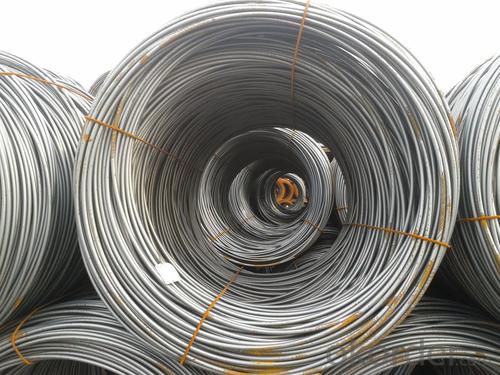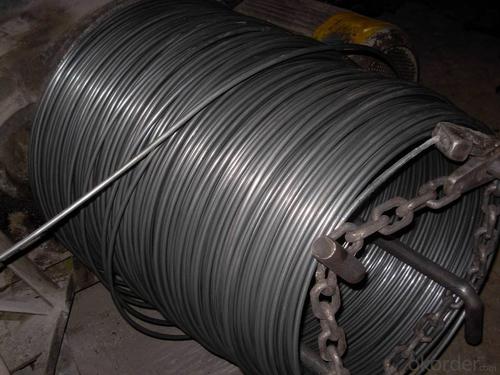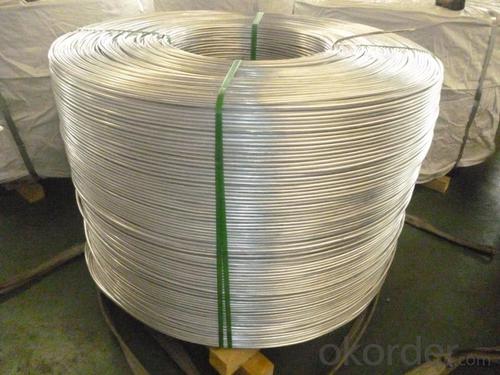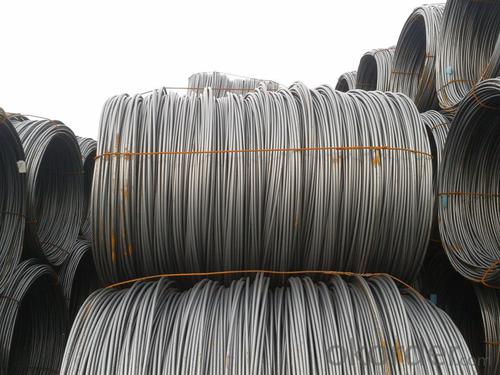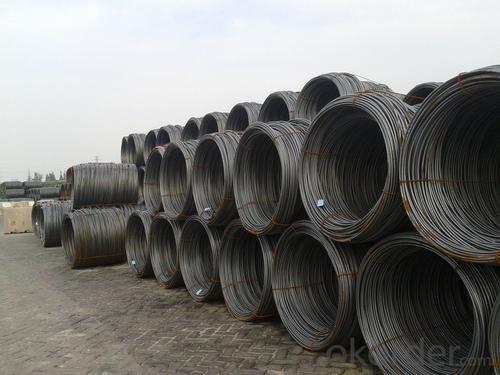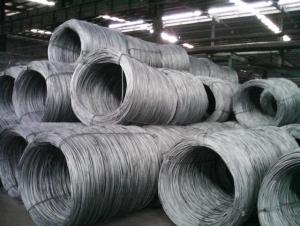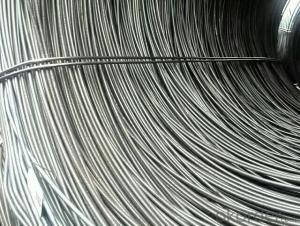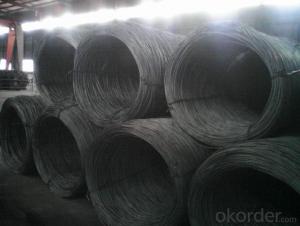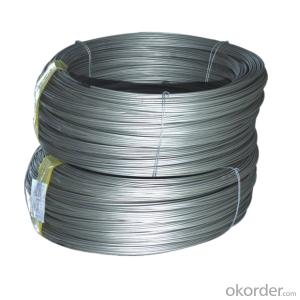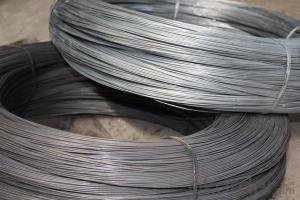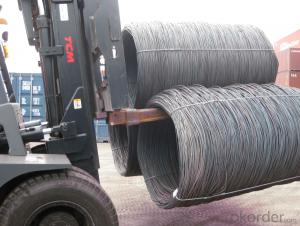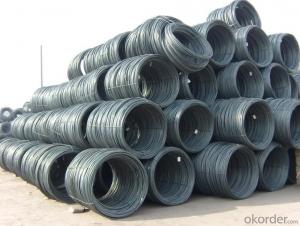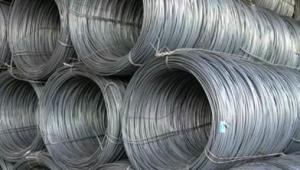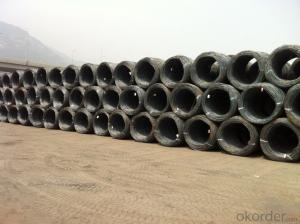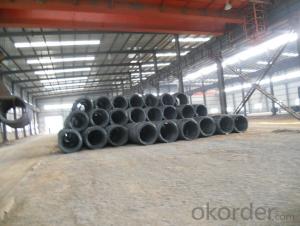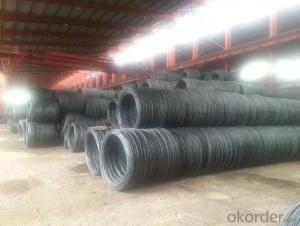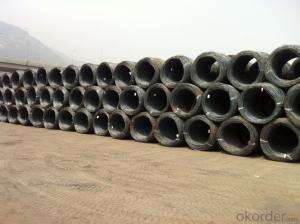SAE1006Cr Carbon Steel Wire Rod 13.5mm for Welding
- Loading Port:
- Shanghai
- Payment Terms:
- TT OR LC
- Min Order Qty:
- 100 m.t
- Supply Capability:
- 30000 m.t/month
OKorder Service Pledge
OKorder Financial Service
You Might Also Like
Specification
Description of SAE1006Cr Carbon Steel Wire Rod 13.5mm for Welding:
OKorder is offering Color Coated Steel Coil Prepainted Steel Coil at great prices with worldwide shipping. Our supplier is a world-class manufacturer of steel, with our products utilized the world over. OKorder annually supplies products to European, North American and Asian markets. We provide quotations within 24 hours of receiving an inquiry and guarantee competitive prices.
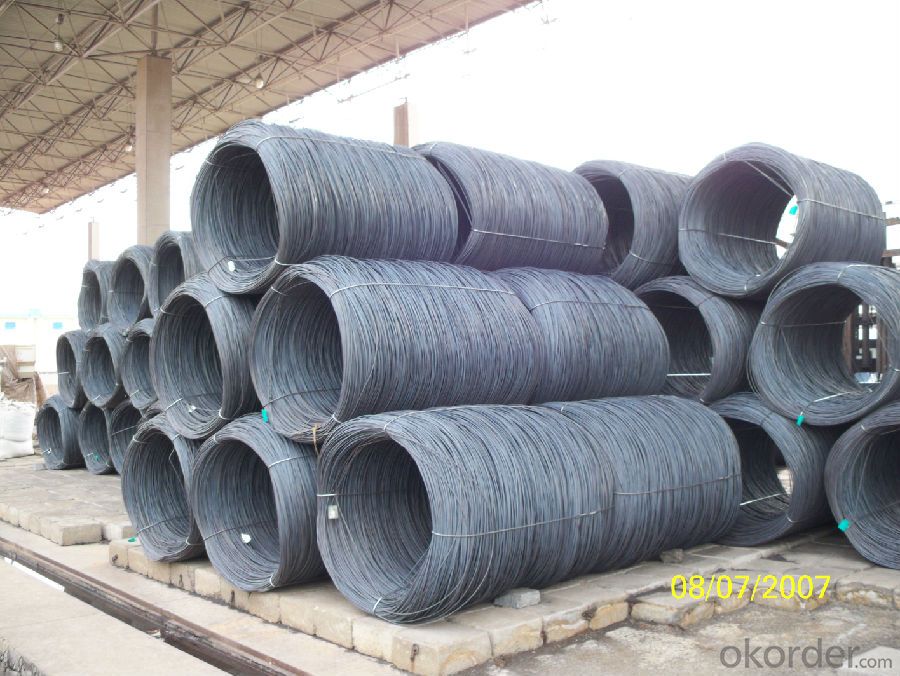
Applications of SAE1006Cr Carbon Steel Wire Rod 13.5mm for Welding:
Color Coated Steel Coil Prepainted Steel Coil are ideal for structural applications and are widely used in the construction of buildings and bridges, and the manufacturing, petrochemical, and transportation industries.
Main Product Features of SAE1006Cr Carbon Steel Wire Rod 13.5mm for Welding:
· Premium quality
· Prompt delivery & seaworthy packing (30 days after receiving deposit)
· Corrosion resistance
· Can be recycled and reused
· Mill test certification
· Professional Service
· Competitive pricing
Specifications of SAE1006Cr Carbon Steel Wire Rod 13.5mm for Welding:
1, Introduction: Color coated steel coils(sheets), i. E. PPGI, also called prepainted steel coils(sheets), are made of galvanized steel coils(sheets) with polymer coatings as surface. It's a new enclosure material and building board with characteristics of light-weighted, heat preserved&insulated, easily installed with bright colors.
2, Production Process: Pretreatment(Degreasing)_Drying_Chromating_Paint Basic Oil_Cooling_Drying_Color Coating_Cooling_Film-covering_Rolling Up
3, Characteristics:
Good at corrosion resistence. Besides zinc coating of the basic plate of galvanized steel sheet, the color coating as the surface has double lifetime to ensure better anticorrosion effect.
With excellent cold bending molded manufacturablity, PPGI products can be processed or directly used as final product. As being light-weighted and conveniently transported, they're widly used to replace wood to save energy.
4.There're thousands of colors can be chosen as per different application. Any color plays well in decoration.
No pollution with high recycling rate, PPGI coils and sheets are strongly recommended as enviroment-friendly products by the government.
5, eye bands and 4 circumferential bands in steel, galvanized metal fluted rings on inner and outer edges, galvanized.
| commodity | SAE1006Cr Carbon Steel Wire Rod 13.5mm for Welding |
| Techinical Standard: | JIS G3302-1998, EN10142/10137, ASTM A755 |
| grade | Q195,Q215,Q235,SAE1006,SAE1008 SAE1006Cr |
| Types: | Mesh welding |
| Base metal | galvanized, galvalume, cold rolled steel |
| Thickness | 0.14-1.0mm(0.16-0.8mm is the most advantage thickness) |
| Width | 610/724/820/914/1000/1200/1219/1220/1250mm |
| Type of coating: | PE, SMP, PVDF |
| Zinc coating | Z60-150g/m2 or AZ40-100g/m2 |
| Top painting: | 5 mic. Primer + 15 mc. R. M. P. |
| Back painting: | 5-7 mic. EP |
| Color: | According to RAL standard |
| ID coil | 508mm610mm |
| Coil weight: | 2--3MT |
| Package: | Properly packed for ocean freight exportation in 20'containers |
| Application: | Industrial panels, roofing and siding for painting/automobile |
| Price terms | FOB, CFR, CIF |
| Payment terms | 20%TT in advance+80% TT or irrevocable 80%L/C at sight |
| delivery time | 25 days after recepit of 20% TT |
| Remarks | Insurance is all risks |
| MTC 3.1 will be handed on with shipping documents | |
| We accept SGS certificatation test |
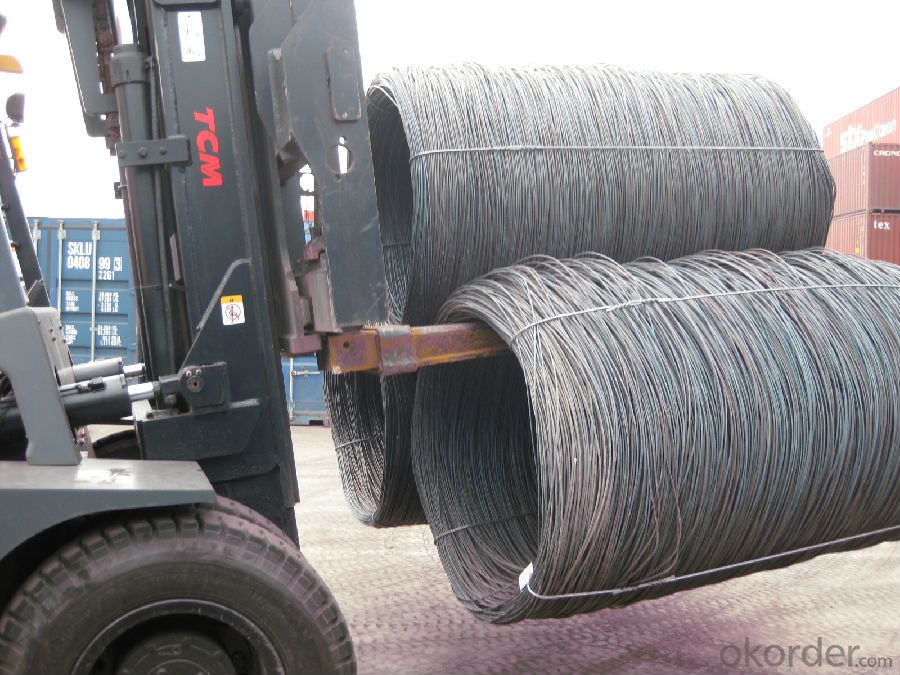
FAQ of SAE1006Cr Carbon Steel Wire Rod 13.5mm for Welding:
Q1: Why buy Materials & Equipment from OKorder.com?
A1: All products offered byOKorder.com are carefully selected from China's most reliable manufacturing enterprises. Through its ISO certifications, OKorder.com adheres to the highest standards and a commitment to supply chain safety and customer satisfaction.
Q2: How do we guarantee the quality of our products?
A2: We have established an advanced quality management system which conducts strict quality tests at every step, from raw materials to the final product. At the same time, we provide extensive follow-up service assurances as required.
Q3: How soon can we receive the product after purchase?
A3: Within three days of placing an order, we will begin production. The specific shipping date is dependent upon international and government factors, but is typically 7 to 10 workdays.
Q4: What makes stainless steel stainless?
A4: Stainless steel must contain at least 10.5 % chromium. It is this element that reacts with the oxygen in the air to form a complex chrome-oxide surface layer that is invisible but strong enough to prevent further oxygen from "staining" (rusting) the surface. Higher levels of chromium and the addition of other alloying elements such as nickel and molybdenum enhance this surface layer and improve the corrosion resistance of the stainless material.
Q5: Can stainless steel rust?
A5: Stainless does not "rust" as you think of regular steel rusting with a red oxide on the surface that flakes off. If you see red rust it is probably due to some iron particles that have contaminated the surface of the stainless steel and it is these iron particles that are rusting. Look at the source of the rusting and see if you can remove it from the surface.
- Q: How is steel wire rod used in the manufacturing of paper clips?
- Steel wire rod is used in the manufacturing of paper clips as it provides the necessary strength and flexibility required to form the clip shape. The rod is first cut into small lengths and then bent into the classic paper clip design using specialized machinery. This process ensures that the paper clips are durable and can securely hold papers together.
- Q: How is the steel wire rod industry affected by fluctuations in raw material prices?
- The steel wire rod industry experiences significant effects due to fluctuations in raw material prices. Raw materials, including iron ore, coal, and scrap metal, play a crucial role in the production of steel wire rods. Any changes in the prices of these raw materials can directly influence the production costs for manufacturers of steel wire rods. When there is an increase in raw material prices, it directly raises the input costs for producing steel wire rods. This situation puts pressure on manufacturers to either absorb the higher costs, leading to reduced profit margins, or pass on the increased costs to customers in the form of higher prices. In either scenario, the competitiveness of steel wire rod manufacturers in the market can be impacted. On the contrary, when there is a decrease in raw material prices, it can provide some relief to steel wire rod manufacturers as it reduces their production costs. This enables manufacturers to offer lower prices or maintain their profit margins while remaining competitive in the market. Fluctuations in raw material prices also have an impact on the supply chain of the steel wire rod industry. Manufacturers depend on a steady supply of raw materials, and any disruptions or price volatility can affect their ability to procure sufficient quantities of raw materials. This can result in production delays, higher inventory costs, and overall productivity issues in the industry. Furthermore, fluctuations in raw material prices can also influence the profitability of steel wire rod manufacturers. If raw material prices increase significantly and manufacturers are unable to pass on the increased costs to customers, it can lead to reduced profitability and potentially financial losses. Conversely, when raw material prices decrease, manufacturers may experience improved profitability. In conclusion, fluctuations in raw material prices directly impact various aspects of the steel wire rod industry, including production costs, competitiveness, supply chain, and profitability. Consequently, industry players closely monitor and analyze trends in raw material prices to make informed decisions and mitigate the impacts of price fluctuations.
- Q: What are the common production processes for boron-coated steel wire rod?
- The common production processes for boron-coated steel wire rod typically include wire drawing, boron coating, annealing, and final finishing.
- Q: What are the different types of wire ropes for cranes made from steel wire rod?
- Cranes commonly utilize various types of wire ropes made from steel wire rod. These include: 1. Galvanized Steel Wire Rope: To safeguard against corrosion and rust, this wire rope is coated with zinc. It is frequently used in outdoor and marine settings where exposure to moisture is a concern. 2. Stainless Steel Wire Rope: Made from stainless steel with a higher chromium content, this wire rope is extremely resistant to corrosion. It is suitable for use in harsh environments like chemical plants or offshore installations. 3. Non-Rotating Wire Rope: This wire rope is designed to resist rotation when under load. It consists of multiple layers of wire strands laid in opposite directions to prevent twisting during operation. 4. Compact Wire Rope: Constructed from tightly compacted smaller diameter wires, this wire rope offers increased strength and flexibility. It is ideal for applications with limited space or high breaking load requirements. 5. Plastic Coated Wire Rope: In certain cases, wire ropes are coated with plastic like polyethylene or nylon. This coating offers additional protection against abrasion and wear and can reduce noise and vibration during use. Ultimately, the choice of wire rope depends on the specific requirements of the crane and the operating conditions. Factors such as load capacity, environmental conditions, and the need for rotation resistance all contribute to determining the most suitable wire rope for a particular application.
- Q: What are the main factors influencing the choice of steel wire rod supplier?
- The main factors influencing the choice of steel wire rod supplier include the supplier's reputation in terms of quality and reliability, their ability to meet specific requirements and specifications, competitive pricing, timely delivery, a wide range of product options, and strong customer support and service. Additionally, factors such as the supplier's financial stability, manufacturing capabilities, and their adherence to industry standards and certifications also play a significant role in the decision-making process.
- Q: What are the main factors influencing the choice of steel wire rod order lead time?
- The main factors influencing the choice of steel wire rod order lead time include market demand and availability, production capacity, transportation logistics, supplier lead times, and customer preferences.
- Q: What are the main applications of steel wire rod?
- The main applications of steel wire rod include construction materials, automotive parts, electrical cables, wire mesh, fencing, nails, screws, and various other industrial and commercial products where high tensile strength and durability are required.
- Q: What are the different types of surface defects that can occur on steel wire rod?
- There are several types of surface defects that can occur on steel wire rods, including scale, pits, scratches, cracks, and surface decarburization. These defects can affect the quality and performance of the wire rod, and they need to be carefully inspected and addressed to ensure the reliability and durability of the final product.
- Q: How is steel wire rod used in the manufacturing of wire forms for garage doors?
- Steel wire rod is a crucial component in the manufacturing process of wire forms for garage doors. It serves as the primary material for creating the sturdy and durable wires that are used in the construction of garage doors. Firstly, steel wire rod is carefully selected based on its specific qualities such as strength, flexibility, and corrosion resistance. These characteristics ensure that the wires formed from the rod can withstand the tension and stress that garage doors go through on a daily basis. The manufacturing process begins with the steel wire rod being fed into a wire drawing machine. This machine progressively stretches the rod, reducing its diameter while increasing its length. By repeating this process, the wire is transformed into the desired diameter and length needed for the wire forms. Once the wire has been drawn, it is then shaped into various forms that are essential for the functioning of the garage door. For instance, the wire may be bent or coiled to create springs that provide the necessary counterbalance to the weight of the door. These springs are crucial for the smooth operation and proper balance of the garage door. Additionally, the wire may also be formed into cables or tracks that guide the movement of the garage door along its path. These cables and tracks ensure that the door moves smoothly and securely, minimizing any potential damage or accidents. Furthermore, steel wire rod is also used to create reinforcement bars that add strength and stability to the different components of the garage door. These reinforcement bars are strategically placed in areas that are prone to stress and strain, such as hinges and tracks, to prevent deformation or failure. Overall, steel wire rod plays a vital role in the manufacturing of wire forms for garage doors. Its strength, flexibility, and corrosion resistance make it the ideal material for creating wires that can withstand the demanding requirements of garage door operation.
- Q: How are steel wire rods used in the manufacturing of welding wires for joining metals?
- Steel wire rods are used in the manufacturing of welding wires for joining metals by being drawn down to the desired size and coated with a flux material. This process ensures that the welding wire has the necessary strength and durability to effectively join metals together during the welding process.
Send your message to us
SAE1006Cr Carbon Steel Wire Rod 13.5mm for Welding
- Loading Port:
- Shanghai
- Payment Terms:
- TT OR LC
- Min Order Qty:
- 100 m.t
- Supply Capability:
- 30000 m.t/month
OKorder Service Pledge
OKorder Financial Service
Similar products
Hot products
Hot Searches
Related keywords

